Can Squirrels Drown? Find Out Here
Squirrels are fascinating creatures known for their acrobatic abilities and nimble movements. But what happens when they encounter water? Have you ever wondered ‘can squirrels can drown’? Let’s uncover some facts about squirrels, drowning and their unique adaptations.
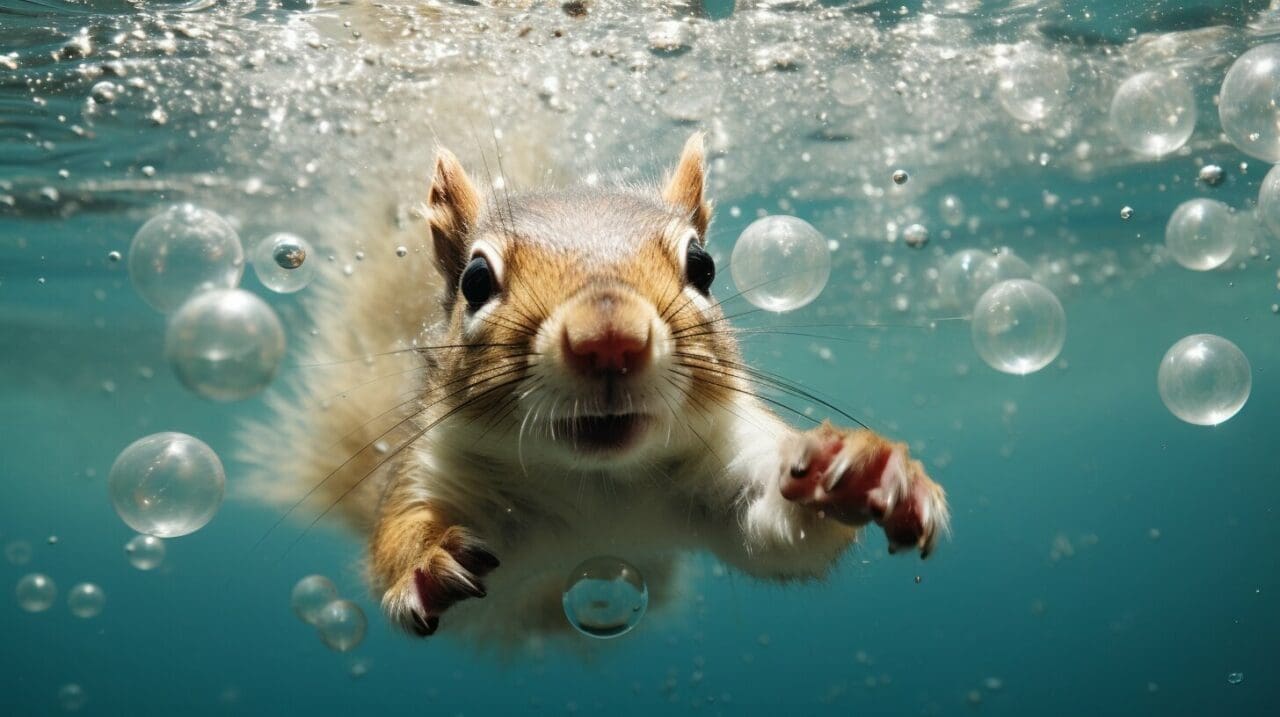
Can Squirrels Drown?
Yes, squirrels can drown. They can swim for short distances but cannot breathe underwater or swim for prolonged periods.
Key Takeaways:
- Gray, fox, and red squirrels can swim using their tails as a rudder, while flying squirrels struggle in water.
- Squirrels may swim when being chased by predators or in search of food, using the dog paddle technique.
- Accidental drowning can occur if squirrels are purposefully soaked underwater.
Squirrel Swimming Habits and Adaptations
Squirrels possess fascinating swimming habits and adaptations that allow them to navigate in water, although their swimming skills may not be exceptional. The gray, fox and red squirrels are known to be capable swimmers, utilizing their bushy tails as a rudder to maneuver through the water. On the other hand, flying squirrels, with their unique gliding webbing, find it more challenging to swim effectively.
When squirrels encounter situations that necessitate swimming, such as being chased by predators or searching for food, they exhibit a dog paddle technique. This method involves using all four of their limbs to paddle and propel themselves forward. While squirrels can swim, their gliding webbing hampers their ability to move swiftly and efficiently in water.

Accidental drowning is a potential risk for squirrels, particularly when they are intentionally submerged underwater. Although squirrels can swim for extended periods, they eventually tire and require rest. It’s important to note that squirrels rely on water for survival, but they can survive without it for approximately 5 to 8 days.
Furthermore, squirrels exhibit incredible survival skills when falling from great heights. Their unique anatomy and ability to control their movements in the air allow them to land safely. Squirrels boast a thick skull, a flexible spine, and robust legs and feet, all of which help absorb the impact of a fall.
By spreading out their legs and tail, squirrels can slow their descent and utilize their tail as a rudder to guide their landing. These adaptations enable squirrels to recover quickly from injuries and have robust immune systems, making them incredibly adaptable and agile creatures.
Types of Squirrels and Their Swimming Abilities
Different squirrels exhibit varying swimming abilities, with ground-dwelling squirrels utilizing their tails as rudders while swimming, unlike their gliding counterparts, the flying squirrels. Gray squirrels, fox squirrels, and red squirrels all possess the ability to swim when necessary.
They use their tails to navigate the water, acting as a rudder to steer themselves in different directions. This adaptation allows them to explore water sources and escape from potential predators.
Gray squirrels, known for their excellent adaptability, are particularly adept at swimming. They can traverse bodies of water such as lakes and ponds using a dog paddle technique. On the other hand, Fox squirrels may not be as proficient in swimming as the gray squirrels but can still navigate through water when needed. Red squirrels, with their smaller size, also can swim using their tails for propulsion.
Flying squirrels, with their gliding webbing, are not well-equipped for swimming. The gliding membrane between their limbs prevents them from propelling themselves in water efficiently. As a result, flying squirrels are more likely to struggle and become exhausted in aquatic environments. They prefer to stay near trees and rely on their gliding abilities to move swiftly through the air rather than in water.
| Squirrel Species | Swimming Abilities |
|---|---|
| Gray Squirrels | Excellent swimmers; use tails as rudders |
| Fox Squirrels | Able to swim but not as proficient as gray squirrels |
| Red Squirrels | Capable of swimming using tails for propulsion |
| Flying Squirrels | Not well-suited for swimming due to gliding webbing |
Understanding the swimming abilities of different squirrel species provides insights into their survival strategies and behavior in the wild. While ground-dwelling squirrels utilize their tails to maneuver in the water, flying squirrels rely on their gliding abilities to stay airborne and avoid water as much as possible. These adaptations have allowed squirrels to thrive in various environments, using their swimming abilities to their advantage when necessary.
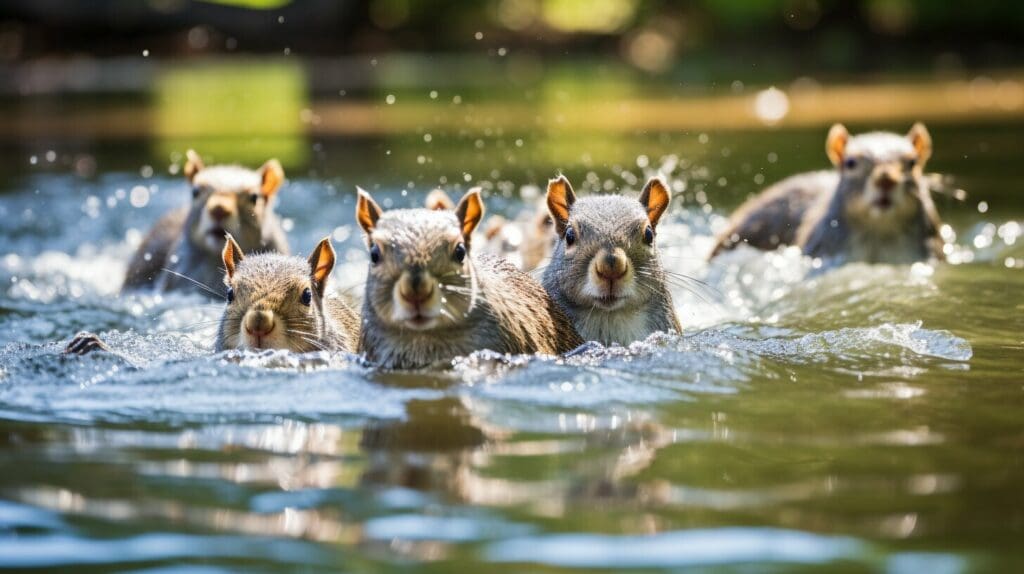
When Do Squirrels Swim?
Squirrels are known to swim in certain situations, including when predators are pursuing them or when they are in search of food. While squirrels are not exceptional swimmers, they can rely on their instincts to navigate through water bodies such as lakes and ponds. When faced with danger, squirrels may take to the water to escape their predators, using their tails as a rudder to steer their way to safety.
Swimming also becomes necessary for squirrels when they are in search of food. They may swim across bodies of water to reach new foraging grounds or access food sources on the other side. Despite not being proficient swimmers, squirrels can use the dog paddle technique to stay afloat and paddle their way to their desired destination.
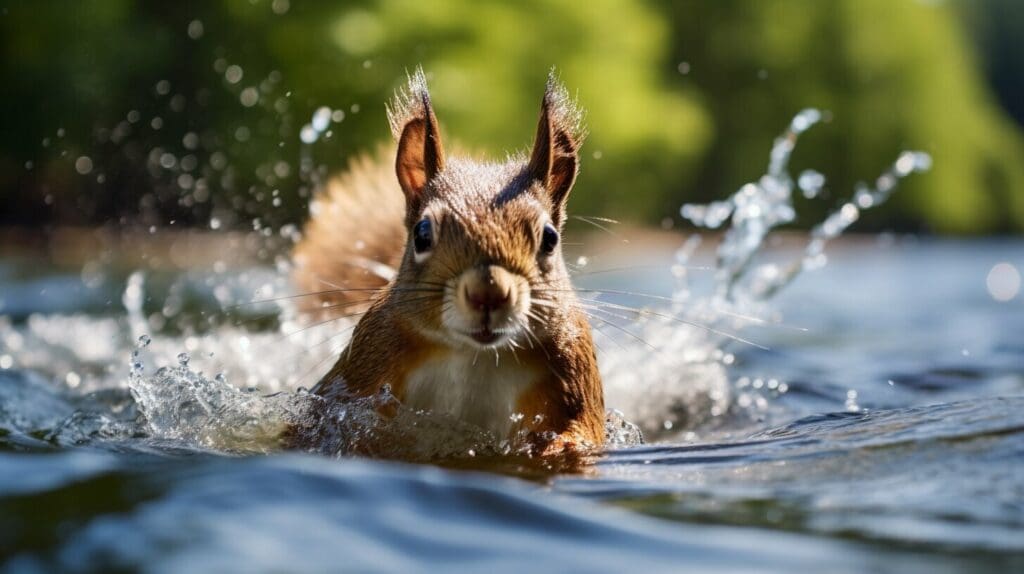
It is important to note that flying squirrels have certain limitations when it comes to swimming. Their gliding webbing, which allows them to glide through the air, becomes a hindrance in the water, slowing them down and making their movements more difficult. While they can swim for a period of time, flying squirrels eventually tire out and need to rest.
Squirrels may not be the most skilled swimmers, but they do possess the ability to swim when necessary. Whether it’s to escape predators or find food, squirrels adapt to their surroundings and utilize their natural instincts to navigate through water. Their swimming abilities, though limited, showcase their agility and adaptability as they continue to thrive in various environments.
Subscribe to the Free VIP Squirrel Scoop Insider Magazine
Written by none other than Bart the Balcony Squirrel, this lighthearted take on life and current squirrel-related world events is sure to bring a smile to your face. From his perch on the Kitty City Squirrels balcony, Bart brings a unique and entertaining perspective to every issue. Why wait, Subscribe now!
Swimming Techniques and Limitations
Squirrels utilize the dog paddle technique to swim, but their gliding webbing can limit their swimming abilities, causing them to swim slowly and with inconvenience. Unlike other mammals, squirrels are not built for efficient swimming. Their webbing, which aids in gliding from tree to tree, hinders their ability to move smoothly through water. This webbing creates drag, making it challenging for squirrels to propel themselves forward.
Despite their limitations, squirrels have adapted to survive in water when necessary. They may resort to swimming when chased by predators or when searching for food near lakes and ponds. While their swimming may not be graceful, squirrels can manage to stay afloat by paddling their legs and using their tail as a rudder.
Accidental drowning can occur if squirrels are purposefully soaked underwater or if they become exhausted while swimming. Therefore, it is essential to ensure their safety around water to prevent such incidents. Squirrels are agile creatures, but water can pose a significant risk to their survival.
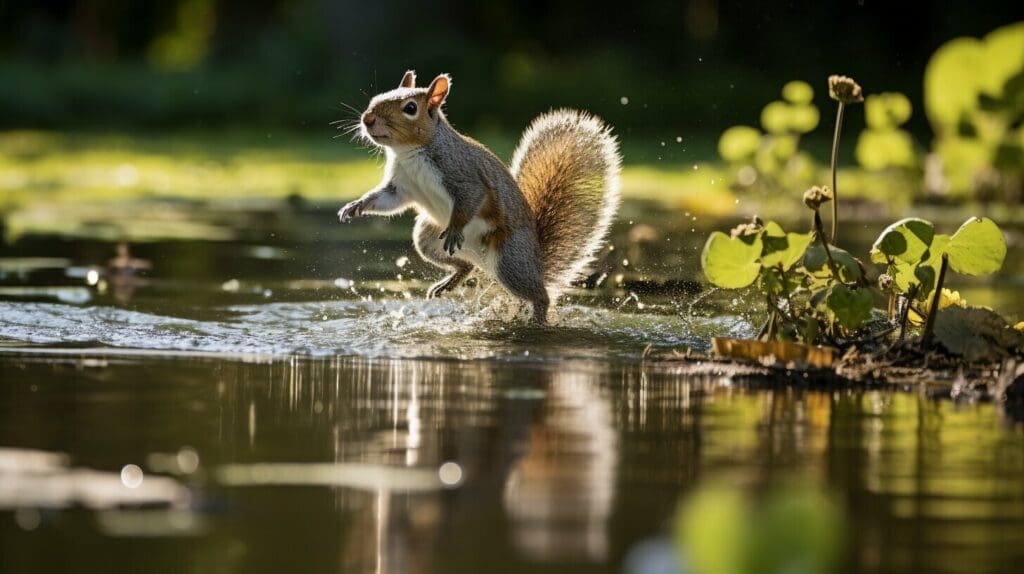
| Swimming Techniques | Swimming Limitations |
|---|---|
|
|
“Squirrels utilize the dog paddle technique to swim, but their gliding webbing can limit their swimming abilities, causing them to swim slowly and with inconvenience.”
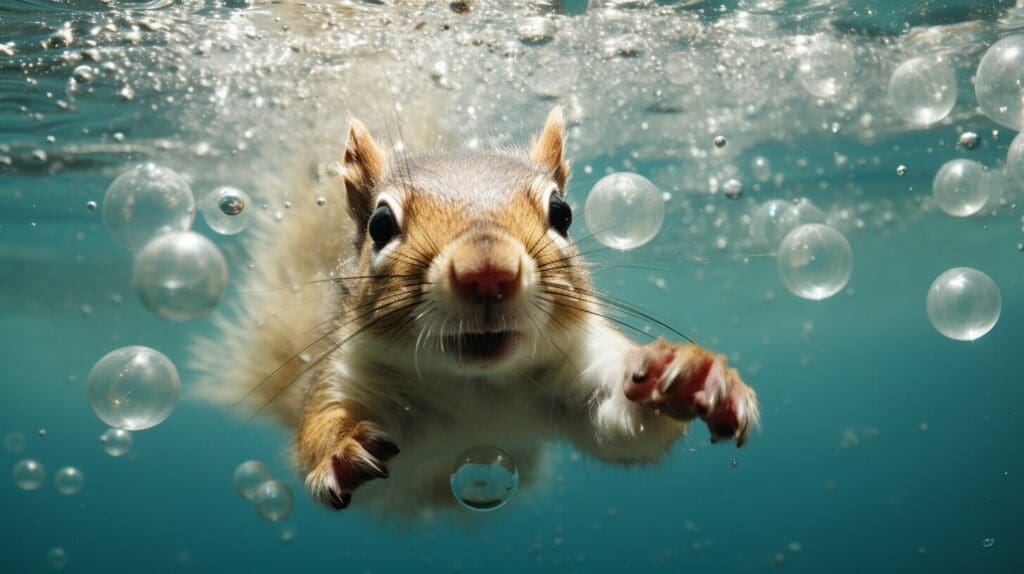
Looking for a Rehabber? Here are 3 Resources
- Squirrel Rehab Locator Map – input your zip code or city into the search bar of Google Maps.
- Animal Help Now – licensed rehabber directory
- Squirrel Connections – licensed rehabber directory by state
Conclusion
In conclusion, while squirrels can swim, their abilities are not exceptional, and there is a risk of accidental drowning, making water safety an important consideration for these fascinating creatures.
Squirrels, such as the gray, fox, and red squirrels, are capable of swimming using their tails as a rudder to navigate. However, flying squirrels, with their gliding webbing, struggle in the water and are not adept swimmers. It is important to note that squirrels may swim when necessary, such as when being chased by predators or searching for food.
When squirrels swim, they rely on the dog paddle technique to stay afloat. Due to their gliding webbing, squirrels may swim slowly and awkwardly. Accidental drowning can occur, particularly if squirrels are intentionally submerged underwater. While squirrels can swim for extended periods, they eventually become exhausted and require rest.
FAQ
Q: Can squirrels swim?
A: Yes, squirrels can swim, but they are not exceptional at it.
Q: Which types of squirrels can swim?
A: Gray, fox, and red squirrels can swim using their tails as a rudder.
Q: Why do squirrels swim?
A: Squirrels may swim when being chased by predators or searching for food.
Q: How do squirrels swim?
A: Squirrels use the dog paddle technique to swim.
Q: Are squirrels great swimmers?
A: No, squirrels are not great swimmers due to their gliding webbing and may swim slowly and inconveniently.
Q: Can squirrels drown?
A: Yes, squirrels can drown, especially if purposefully soaked underwater.
Q: How long can squirrels swim?
A: Squirrels can swim for a long time, but they eventually get exhausted and need to rest.
Q: How long can squirrels survive without water?
A: Squirrels can survive without water for around 5 to 8 days.
Q: Can squirrels survive without water during hibernation?
A: Yes, squirrels can hibernate without water for up to 8 months.
Q: Can squirrels survive falls from great heights?
A: Yes, squirrels have unique anatomy and adaptations that allow them to survive falls from great heights.
Q: How do squirrels control their descent during falls?
A: Squirrels spread out their legs and tail to slow their descent and use their tail as a rudder to control their landing.
Q: How quickly do squirrels recover from injuries?
A: Squirrels can recover quickly from injuries due to their resilience and strong immune systems.
Q: Are squirrels agile and adaptable creatures?
A: Yes, squirrels are agile and adaptable creatures that employ various survival strategies.





